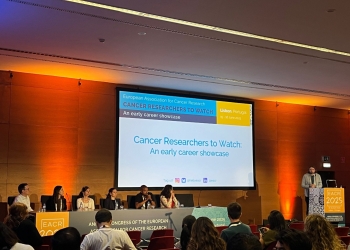The EACR’s ‘Highlights in Cancer Research’ is a regular summary of the most interesting and impactful recent papers in cancer research, curated by the Board of the European Association for Cancer Research (EACR).
The list below appears in no particular order, and the summary information has been provided by the authors unless otherwise indicated.
Use the dropdown menu or ‘Previous’ and ‘Next’ buttons to navigate the list.
Radtke, A. J., Postovalova, E. et al. Cancer Cell 42(3), 444-463.E10 (2024).
doi: 10.1016/j.ccell.2024.02.001.
 Summary of the findings
Summary of the findings
Follicular lymphoma (FL) is a generally incurable cancer that evolves from developmentally blocked B cells. One of the greatest challenges for the treatment and management of FL is the significant clinical heterogeneity observed both within and across patients. The majority of patients experience an indolent clinical course characterized by a relapsing and remitting disease over many years; however, approximately 20% of patients present with an aggressive clinical course with increased risk for premature death.
In this article, the authors used advanced sequencing and imaging technologies to provide a comprehensive examination of the FL tumor microenvironment (TME) from patients enrolled in a prospective clinical trial. By integrating multi-omic technologies, Radtke, Postovalova, and colleagues identified enhanced B cell receptor (BCR) signaling in the tumor B cells of high-risk FL patients suggestive of BCR engagement in the TME. The authors additionally reported the enrichment of distinct histological patterns in high-risk FL patients including alterations in the shape and size of neoplastic follicles and enhanced stromal remodeling. Importantly, these distinguishing features were observed an average of 20 months before first progression and first relapse in an untreated patient cohort, providing a potential means for early patient stratification by risk.

Future impact
Through detailed assessment of the FL TME at single cell and spatial resolution, this work discovered a new cell type now confirmed by others: dendritic cell–specific ICAM-3–grabbing nonintegrin (DC-SIGN)–expressing follicular dendritic cells. Future impact of this work includes extending these findings to a larger clinically annotated cohort to evaluate whether the histological patterns described here can reliably predict disease behavior. Furthermore, this work may inform treatment strategies for high-risk FL patients such as anti-fibrotic agents or therapies that inhibit DC-SIGN-induced BCR signaling.









